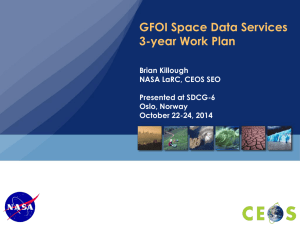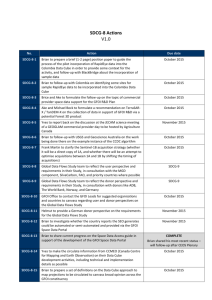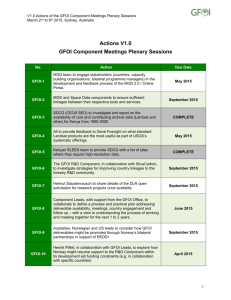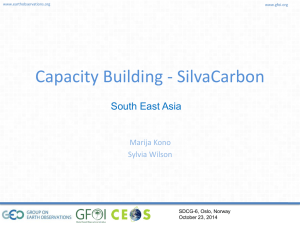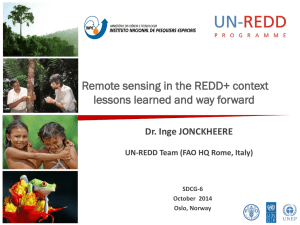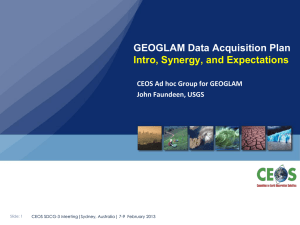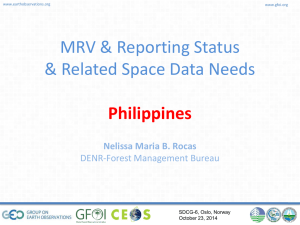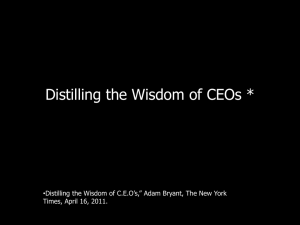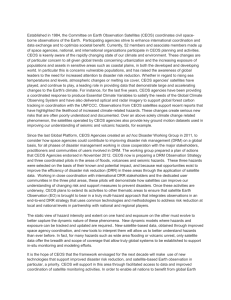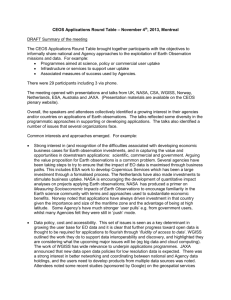SIT-25 final minutes
advertisement
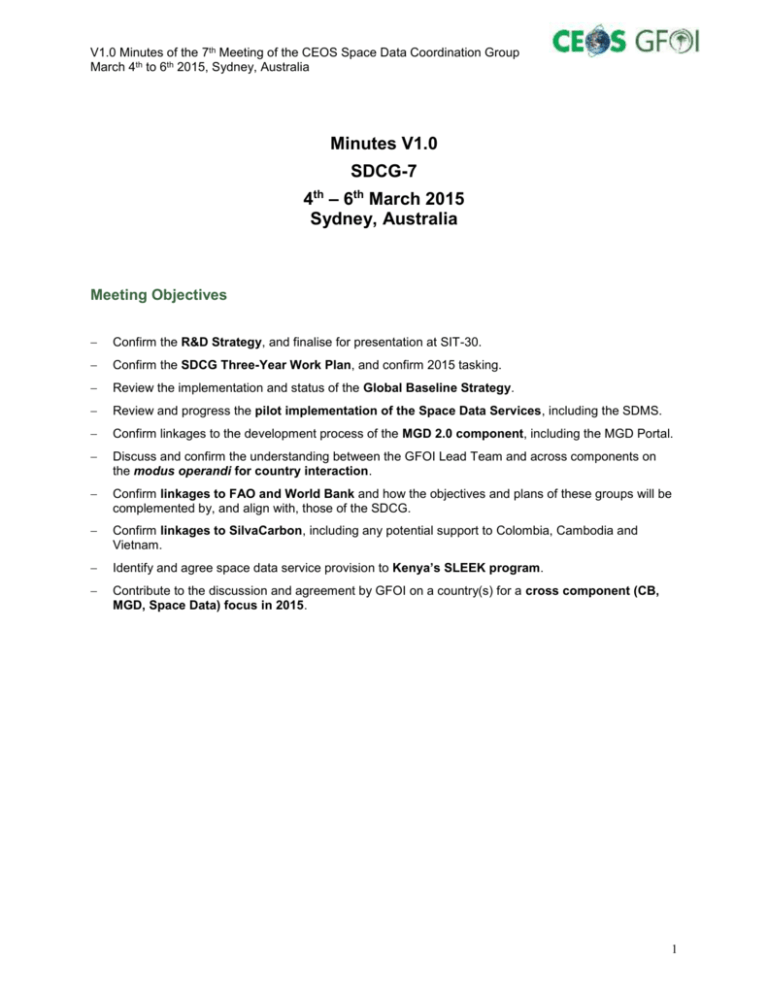
V1.0 Minutes of the 7th Meeting of the CEOS Space Data Coordination Group March 4th to 6th 2015, Sydney, Australia Minutes V1.0 SDCG-7 4th – 6th March 2015 Sydney, Australia Meeting Objectives Confirm the R&D Strategy, and finalise for presentation at SIT-30. Confirm the SDCG Three-Year Work Plan, and confirm 2015 tasking. Review the implementation and status of the Global Baseline Strategy. Review and progress the pilot implementation of the Space Data Services, including the SDMS. Confirm linkages to the development process of the MGD 2.0 component, including the MGD Portal. Discuss and confirm the understanding between the GFOI Lead Team and across components on the modus operandi for country interaction. Confirm linkages to FAO and World Bank and how the objectives and plans of these groups will be complemented by, and align with, those of the SDCG. Confirm linkages to SilvaCarbon, including any potential support to Colombia, Cambodia and Vietnam. Identify and agree space data service provision to Kenya’s SLEEK program. Contribute to the discussion and agreement by GFOI on a country(s) for a cross component (CB, MGD, Space Data) focus in 2015. 1 V1.0 Minutes of the 7th Meeting of the CEOS Space Data Coordination Group March 4th to 6th 2015, Sydney, Australia Thursday 5th March 1 1.1 SDCG-7 Kick-Off SDCG Meeting Introduction and Objectives Stephen Briggs welcomed everyone to the meeting and Stephen Ward introduced some of the key topics for discussion during SDCG-7: Stephen Ward noted that the concept and planning phases of SDCG are complete, and now attention needs to turn to ensuring that SDCG is fully integrated with the other components of GFOI to ensure that countries receive the necessary deliverables. Primarily we need a coherent country engagement strategy from the rest of the GFOI; and, We need to confirm the Element 3 R&D Strategy; SDCG 3-Year Work Plan; review the implementation of the Global Baseline Observation Strategy; confirm linkages to the MGD (including the new Online Portal), FAO, World Bank and SilvaCarbon; identify and agree the support to Kenya’s SLEEK program; and finally we need to understand how all of this can come together in support of a cross component national model system. A brief discussion followed: Stephen Ward recalled that during Alex Held’s final plenary presentation on R&D, Henrik Fliflet agreed to consider whether Norway could fund specific R&D activities in country. Stephen Briggs noted that everyone has agreed that GOFC-GOLD should take over leadership of the GFOI R&D component, and he has suggested to Norway that they might like to consider funding some elements in the future, noting that ESA has been funding the GOFC-GOLD Land Cover Office for over a decade and welcome contributions from others; Stephen Briggs added that there was some confusion around the meaning of ‘country engagement’ during the plenary sessions. When the SDCG speaks about country engagement we are referring to a GFOI-wide strategy, in collaboration with in-country partners such as the FAO and WB; and, Stephen Briggs reported that a meeting will be taking place on the 14th and 15th of April at FAO, which will be attended by SilvaCarbon, and will aim to produce a list of priority countries, their requirements, and engagement strategies for the next couple of years. 1.2 SDCG-6 Action Status George reviewed the SDCG-6 action status (see presentation for details), and the SDCG discussed some select actions: Brian is unable to report on action SDCG-6-30 yet, and indicated that he would like to see the outcome from the April FAO-SilvaCarbon meeting before committing. He would like to see a summary of country activities and engagement status with FAO, WB FCPF, SilvaCarbon, etc. to come out of the meeting in April; and, Stephen Briggs reminded everyone that we are not trying to push or promote the MGD; we are simply offering a service to those that are interested, noting that it is not our responsibility to push services and data on those who do not need or want it. 2 V1.0 Minutes of the 7th Meeting of the CEOS Space Data Coordination Group March 4th to 6th 2015, Sydney, Australia 2 2.1 SDCG 3-Year Work Plan 2015-2017 3-Year Work Plan Status and Overview and Discussion Stephen reviewed the SDCG’s 3-Year Work Plan, noting that it aims to support external and internal communication, plan the next phases of SDCG support to GFOI and highlight the inputs required from the GFOI Lead Team. The document is outcome-centric and represents the SDCG’s vision for the next few years. Stephen noted the following points: The 3-Year Work Plan has been progressing for 9 months thanks to the inputs of the whole SDCG, and we are seeing an increased number of actions and outcomes related to commercial sector engagement; and, We are here this week to confirm the tasking, identify the actions required to complete the plan, and to hear from each of the task leads on their individual plans and statuses. A discussion followed: Yves Crevier asked whether there is a defined end goal for the SDCG, and whether it is clear whether we hand over or remain active in support of GFOI once we reach this point. He added that if this is not clear, it should be added to the 3-Year Work Plan; Yves also stressed that we need to remain focused on the tasks that space agencies have control over, ensuring not to be caught up in areas that are not our responsibility; Yves suggested that the 3-Year Work Plan be assessed against the original ToR for the SDCG, to determine whether we are on track and focused; Helmut Staudenrausch supported the comments made by Yves. Erik Lindquist stressed the need to clearly specify in the 3-Year Work Plan that country engagement will occur at the level of FAO/SilvaCarbon, with the SDCG responding to requests received through these efforts. He added that it was initially agreed that the SDCG should not be doing direct engagement with the countries but rather providing support to the agencies that are engaging with countries directly; Stephen Ward noted that GFOI component coordination and country engagement section is not really an SDCG topic, and it was included in the plenary sessions to prompt a response from the GFOI Lead Team and to point out that we require their assistance on these topics; Ake Rosenqvist would like to see a formal task/outcome included in the 3-Year Work Plan related to the hand over of SDCG R&D responsibility to ESA; and, Stephen thanked the SDCG again for their contribution to the 3-Year Work Plan, and noted that he wishes to close out the document within a week. SDCG-7-1 CEOS SEO to coordinate with ESA, USGS and GA on the planning, definition, and progressing of the initial implementation steps of Outcomes 11 and 12 (cloud computing pilots) in the SDCG 3-Year Work Plan. SDCG-8 SDCG-7-2 Stephen Ward to confirm the content of outcomes 3 (around standard products) and 10 (integration of space data within the MGD) from the SDCG 3-Year Work Plan with the MGD component manager, including around the objective of the SDCG Data Cube to focus on standard surface reflectance products. SIT-30 3 V1.0 Minutes of the 7th Meeting of the CEOS Space Data Coordination Group March 4th to 6th 2015, Sydney, Australia SDCG-7-3 Stephen Ward and George Dyke to define additional milestones for the advancement of Kenya as a national model implementation of the Space Data Services for outcome 11 in the 3-Year Work Plan. SDCG-7-4 SDCG EXEC to include an SDCG 3-Year Work Plan task to propose a mechanism to address the coordination and collection of forest-related R&D space data requests. SDCG-7-5 SDCG EXEC to finalise the SDCG 3-Year Work Plan based on discussion at SDCG-7, and submit to the SIT-30 document approval process. COMPLETE SDCG-7-6 SDCG EXEC, in collaboration with the MGD component manager, to draft a 1-2 page assessment of the potential roles and interactions between the GFOI Space Data Component and the GFW. SDCG-8 3 3.1 SIT-30 Task defined by SIT-30, mechanism definition by SDCG-8 Baseline Global Observation Scenario Session Introduction Gene Fosnight reviewed the Baseline Global Observation Scenario outcomes and the plan to achieve them, noting that: The outcomes are focused on ensuring consistency of global acquisitions, assessing efficient and effective global flows of data, and developing consistent information products; The outcomes in the 3-Year Work Plan reflect the transition to an agency emphasis on data and information selection and the delivery and provision of analysis ready data; Gene noted that the ALOS and ALOS-2 global mosaics and SPOT data archive are integral to the Baseline Global Observation Scenario; and, Gene pointed out that we need clear statements of capacity building needs (in terms of tools and data discovery) and R&D requirements (e.g. what is our role for integrating radar data) so that we can assess what space agency resources are available to help achieve the desired outcomes. A discussion was held on strategies for dealing with large future datasets, including alternative data distribution methodologies: Gene feels that this is an issue that is really above the SDCG and GFOI, noting that we don't have the skillset or financing to take on these issues, however we can help setup the necessary dialogues with space agencies; Erik Lindquist noted that corrected surface reflectance products direct from the provider would be ideal for FAO activities, however the countries do not want the classification work done for them. He added that analysis ready radar data would be incredibly valuable and is under demand from the countries that FAO is working with. Brian Killough pointed out that this type of data is planned for inclusion in the Data Cube; and, It was pointed out that we should avoid talking about ‘information products’ and instead use the phrase: ‘analysis ready data’. 4 V1.0 Minutes of the 7th Meeting of the CEOS Space Data Coordination Group March 4th to 6th 2015, Sydney, Australia SDCG-7-7 SDCG EXEC to collaborate with GA & the SEO to achieve the 2015 paper on future efficient global data flows (SDCG 3-Year Work Plan Outcome 2) – starting by agreeing the scope and objectives with SDCG. Draft for discussion at SDCG-8 SDCG-7-8 Steven Hosford to confirm some details of the SPOT archive processing including approximate schedule, number of scenes being handled, and current expected completion date. End April 2015 SDCG-7-9 Gene Fosnight to engage with CEOS WGCV (and its Land Cover Validation subgroup) on analysis ready surface reflectance products and USGS activities to see whether their work might be complementary. End April 2015 3.2 USGS Core Data Stream Report Gene Fosnight gave a status report on Landsat 7 and 8 acquisitions, noting that: Since the launch of Landsat 8, Landsat 7 doesn't acquire over islands or Antarctica due to duty cycle restrictions; Between +/-57 degrees latitude USGS are acquiring 99.7% of landmass, and 89.3% of landmass outside of these latitudes; and, USGS are shifting their focus to producing analysis ready data, and he presented the USGS data processing workflow (see slides for details). A discussion followed: Erik Lindquist noted that historic coverage over countries is very much a necessity, and he added that USGS’ efforts to make this data more available is greatly appreciated; and, Erik also clarified that countries can choose the year to use for their reference levels calculations, however this is typically not before 1990. Lots of countries are choosing 1990, however the coverage can be inconsistent, and any action to bring data that hasn't been brought into the accessible archive for 1990 would be particularly helpful. 3.3 ESA Core Data Stream Report Frank Martin Seifert reported on the GFOI-related activities underway at ESA, in particular the status of Sentinel-1A and preparations for the launch of Sentinel-2A: Frank Martin reported that the Sentinel-1A 2-month rolling public archive is still in effect, but to date no data has been deleted. Any required data should be downloaded immediately, as no procedure to access a general archive is in place (only Copernicus services users are able to access the complete archive); Brian noted that NASA is mirroring all data from the Sentinel-1, 3 and 5 missions. USGS will be archiving copies of Sentinel-2 data; Frank Martin is actively pushing for dual polarisation acquisitions for GFOI where possible. In particular he is trying to convert acquisitions over seismic areas and volcanoes in South America, Africa and Indonesia from single to dual polarisation, however there are still limitations related to system capacity during the ramp-up phase; 5 V1.0 Minutes of the 7th Meeting of the CEOS Space Data Coordination Group March 4th to 6th 2015, Sydney, Australia Sentinel-2A is planned to launch on the 12th of June 2015, after which a three-month commissioning phase will follow. Europe, Africa and Asia will be the first priorities during the nine-month Sentinel-2A ramp-up phase; Preliminary site selection for the SPOT 5 Take 5 experiment jointly organised by CNES and ESA has been completed (see: https://earth.esa.int/web/guest/pi-community/news/-/article/spot-5-take-5-sitesassessment-including-list-of-provisional-sites); and, The ESA Thematic Exploitation Platform will facilitate effective and economically sustainable use of computing infrastructure and ground segment capabilities, provide an easy use R&D environment with simple access to EO data and processing tools, and reduce the burden of IT. Frank Martin noted that the UN-REDD team at FAO is involved in the ESA TEP and he added that the TEP will address a sub-country case in Mexico and will be complimentary to the SDMS, with closer collaboration planned. SDCG-7-10 Brian Killough to confirm with Andy Mitchell whether the NASA mirror of the Sentinel-1A rolling archive can be shared with GFOI and other CEOS users. SDCG-7-11 Brian Killough and Frank Martin Seifert to confirm the linkages between the ESA TEP and the SDMS. 3.4 End April 2015 SDCG-8 Other Core Data Stream Reports CSA (Yves Crevier) Yves reported that RCM is now in the construction phase, and that RCM will provide 12-15 minutes of SAR acquisitions per orbit. The primary focus for RCM will be Canadian government services, and international acquisitions will be a secondary priority, but despite this initiatives such as GFOI and GEOGLAM are expected to benefit greatly from the programme. Yves noted that C-band availability in the 2018 time frame will be very good, and that it is now time to start understanding and applying the data products. CNES (Steven Hosford) Steven reviewed the SPOT World Heritage program and its application in support of GFOI: Steven noted that there is a large archive (around 30 million scenes) of data stored at ground stations across the world, and CNES are working to have the data processed and accessible online. He added that current reprocessing efforts are focused on scenes already held by CNES in Toulouse; 100,000 scenes have already been processed and CNES are hoping to secure funding to sustain ongoing processing activities; and, Steven added that CNES are keen to promote the activities of CEOS and GFOI at the upcoming COP-21 meeting in Paris, and Steven would like to identify potential contributions. A discussion followed: Brian Killough suggested that SPOT data for the Kenya Data Cube could be prioritised so that it could be presented as a CNES contribution during the Kenyan’s COP-21 presentation; and, 6 V1.0 Minutes of the 7th Meeting of the CEOS Space Data Coordination Group March 4th to 6th 2015, Sydney, Australia Erik Lindquist noted that pre-2000 SPOT coverage over forested countries would be very useful for the FAO’s in-country activities, and he suggested that these scenes be prioritised. SDCG-7-12 Steven Hosford to coordinate with SDCG EXEC on potential SDCG and GFOI outcomes to include in any CEOS presence at COP-21. SDCG-7-13 SDCG, in consultation with the Capacity Building component and Kenya to advise CNES on priority locations and dates for SPOT reprocessing. 4 SDCG-8 End April 2015 GFOI Space Data Services Outcome Reviews Brian Killough, Stephen Ward and George Dyke lead a discussion and review of the 3-Year Work Plan outcomes related to the GFOI Space Data Services: See the presentation slides for comments and discussion points for each of the outcomes. Erik Lindquist noted that the FAO hasn't used C-band radar in the past partly due to availability, not because it is not useful for their work; Erik reported that Internet capacity in countries is rapidly improving, and the FAO has been funding the installation of high-speed internet for their in-country partners; Erik added that the FAO has a grant from Amazon for AWS, which includes 3 years free hosting, and bandwidth. Brian suggested that it would be good if this could be leveraged for the Kenya Cube, and Erik agreed to check with his management; Brian proposed that the SDCG produce a “GFOI Space Data Access Guide” (see Plenary action GFOI-26) and Erik suggested that it be integrated into COVE once complete; and, Brian presented his vision for model national GFOI data services: 7 V1.0 Minutes of the 7th Meeting of the CEOS Space Data Coordination Group March 4th to 6th 2015, Sydney, Australia SDCG-7-14 Erik Lindquist to confirm with Brian Killough whether FAO would be able to host a Kenya data cube on their AWS infrastructure in the event that Kenya wishes to use the prototype Brian is developing operationally. End April 2015 SDCG-7-15 Brian Killough to confirm whether an updated RapidEye API is available. End April 2015 SDCG-7-16 Ake Rosenqvist to work with Brian Killough on including the ALOS archive in the country coverage assessment and COVE tools. End April 2015 SDCG-7-17 Yves Crevier to work with Brian Killough on including the RADARSAT-1 archive in the country coverage assessment and COVE tools. End April 2015 SDCG-7-18 Brian Killough to follow up with Erik Lindquist for feedback on the archive assessment tools his group are developing. End April 2015 5 5.1 Country Follow-up Country Follow-up Introduction Sylvia Wilson and representatives from each of the countries joined the SDCG for a discussion session to identify country requirements and practical support that the SDCG can provide. 8 V1.0 Minutes of the 7th Meeting of the CEOS Space Data Coordination Group March 4th to 6th 2015, Sydney, Australia 5.2 Kenya Faith Mutwiri presented on the space data and training needs of the Kenyan team, identifying the following key requirements: Space data needs: wall-to-wall coverage for the period 1990-2015, coastal area coverage is a high priority due to constant cloud cover, Landsat L1T data is preferred due to cost and time series availability, high-resolution data (e.g. SPOT) is desired for sampling sites, and January-March acquisitions are preferred as this is the dry season and cloud cover is at a minimum; and, Training is needed in: land cover classification, change detection, uncertainty analysis, use of open source software, MGD best practices, refining/reviewing their process manuals, optimal sampling strategies for a NFI. SDCG-7-19 5.3 CEOS SEO to perform a Kenyan archive analysis back to 1990 for SPOT and Landsat (including MSS) data. COMPLETE Cambodia Sar Sophyra presented a history of Cambodia’s MRV/NFMS implementation and identified some space data/training requirements and challenges: Cambodia’s NFMS was established to provide wall-to-wall monitoring of deforestation, carbon pools, above ground biomass, and GHG emissions; The country has produced a LULC map for 2005 and 2006 and work continues on the 2010, 2013 and 2014 versions. In 2015 they hope to complete their LULC series and finish the development of their web platform; The LULC maps for 2005, 2006 and 2010 were produced using Landsat 7, with ALOS being used for verification of the 2010 map. The maps for 2013 and 2014 use Landsat 8 images, with select RapidEye data being used for verification activities; Required space data: Landsat 8 wall-to-wall, very high-resolution (e.g. RapidEye) for verification activities and radar data to support NFI sampling, SPOT data for early warning monitoring of forest fires; Training needs: methodology refinement, processing tools/software, help integrating maps with inventory plots, production of good quality seasonal data mosaics, capacity building on time series change map generation, LIDAR training (to support forest degradation, selected cutting and biomass estimation); and, Current challenges: need to refine their method for land cover mapping, integration of data sources to fill gaps, access to high-resolution imagery for verification, the high costs of tools and software, sustainable access to data and tools, Sentinel-2 data processing uncertainty, RADAR image processing assistance, integrating in situ with remotely sensed data, coordination with space agencies. A discussion followed: Stephen Ward questioned why SPOT data was requested for forest fire monitoring, noting that SPOT is not suited to time-sensitive applications such as real time forest fire monitoring and early warning. The SDCG Exec offered to send Sar some information on forest fire early detection using MODIS, and will also share the Australian Sentinel example in coordination with Alex Held; 9 V1.0 Minutes of the 7th Meeting of the CEOS Space Data Coordination Group March 4th to 6th 2015, Sydney, Australia Yves Crevier pointed out that there is extensive RADARSAT-1 coverage for the country since 1996; and, Sar noted that SAR training for sampling activities is a priority, and Matt Steventon recalled DLR’s SAR remote sensing education initiative (https://saredu.dlr.de/) SDCG-7-20 Brian Killough to share information with Sar Sophyra (Cambodia) on forest fire early detection using MODIS, including Australia’s Sentinel Hotspot system (in coordination with Alex Held). SDCG-7-21 Sylvia Wilson to confer with SDCG EXEC to specify sites in SilvaCarbon countries with high-resolution data requirements that might be addressed by SDCG brokerage. 5.4 End April 2015 SDCG-8 Colombia Edersson Cabrera presented the space data requirements of the Colombian NFMS: The Colombian ‘semi-annual warning system’ operates on wall-to-wall, coarse resolution optical data, such as from MODIS/VIIRS, as well as wide beam mode L-band (or C-/X-band) SAR; For their annual wall-to-wall assessments, medium resolution optical datasets are used, such as from Landsat 8, as well as fine beam mode L-band (or C-/X-band) SAR (in particular the pacific ocean region of the country is covered by Sentinel-1A in dual-polarisation thanks to interaction with ESA); Edersson noted that Colombia desires a better nation-wide DEM, at the resolution required for the pre-processing steps of their optical and SAR data (such as SRTM/TanDEM-X); Colombia is also planning to use SAR interferometric catalogues to do precision change cover analyses; and, Some of the current challenges faced by Edersson and the Colombian team are: the availability of remotely sensed data for operational MGD implementation, availability of operational pre-processing SAR algorithms, data infrastructure/cloud computing limitations and ongoing funding. The following discussion occurred after the presentation: Edersson identified early warning system supporting data (MODIS/VIIRS) as a priority for Colombia – as well as the need to integrate SAR processing into the early warning system. Brian Killough clarified that the FAO will handle any operational SDMS activities, and that the SEO are only working on prototype services. Brian suggested that in the future a Data Cube could be established for Colombia, and he would welcome partnering with a country that will provide good development feedback; and, Erik Lindquist asked whether the FAO could conceivably purchase DEM data for UN-REDD countries and whether the SDCG could facilitate such a transaction. SDCG-7-22 Helmut Staudenrausch and Frank Martin Seifert to approach Airbus regarding the cost and availability of a 30m TanDEM-X DEM product for Colombia. End April 2015 10 V1.0 Minutes of the 7th Meeting of the CEOS Space Data Coordination Group March 4th to 6th 2015, Sydney, Australia Friday 6th March – Morning Session 6 Space Data Support to GFOI R&D A discussion was held on Space Data Support to GFOI R&D, in particular whether to present the Element 3 Plan for endorsement at SIT, even with the lack of concrete funding arrangement for the GFOI R&D Component. The following points were raised: Yves Crevier noted that there is plenty of space agency funding available for R&D activities but the coordination provided by the Element 3 Plan is necessary to unlock the full potential; Stephen Ward suggested that it might be best to hold off on seeking CEOS endorsement of the Element 3 Plan, given that the R&D Component is still uncertain; Stephen asked whether the agencies have reviewed the GFOI R&D Component Plan, and it was found that they had not. Stephen suggested that the R&D agencies review the R&D Component Plan, and if they are all happy with it, then there are sufficient grounds for pushing forward with endorsement of the Element 3 Plan, given that all agencies expressed their willingness to start contributing; Brian Killough asked whether the SDCG desires a common data services approach, analogous to the JECAM CSA/MDA MURF, and suggested that we define the steps necessary to develop a common user license agreement to host data from commercial and restricted missions from CSA, ASI, DLR, JAXA, RapidEye, etc.; Helmut Staudenrausch noted that DLR would like CEOS to consider a coordinated AO for EO data in response to GFOI R&D to get more teams involved. Ake said that this is a longer term prospect, and for now we should start with the existing teams; Steven Hosford reported that CNES have already received data requests for the existing sites; and, Brian reminded everyone that the SEO aims to set up the tools and data services, but at some point need to transfer responsibility of the prototypes. SDCG-7-23 R&D space agency representatives to read the GFOI R&D Component Plan and the Element 3 (R&D) Acquisition Strategy and provide feedback to Ake by Wednesday 11th March, and indicate their agency’s support for the presentation of the Strategy for endorsement at SIT-30. SDCG-7-24 Brian Killough to circulate the details of the pilot data services the SEO have put in place for JECAM, including the MURF and other data licence mechanisms. 6.1 COMPLETE The Element 3 strategy was endorsed at SIT-30. End April 2015 CSA Contributing Data Stream Report Yves Crevier presented on CSA’s contribution to GFOI R&D, noting that: CSA remains committed to the GFOI R&D activities and the forest community. CSA wish to enable end users to exploit the large amount of SAR data and to focus their investments in support of societal benefit, however CSA is restricted to providing support for R&D with RADARSAT-2 due to its commercial ties; 11 V1.0 Minutes of the 7th Meeting of the CEOS Space Data Coordination Group March 4th to 6th 2015, Sydney, Australia Unprocessed and globally distributed RADARSAT-1 data is available and its usefulness for forest monitoring should be assessed; CSA/MDA and JECAM have instigated a transition to the Multi-User Request Form (MURF) process, which facilitates open sharing of data at the project-level by certifying a group of users to access a pool of data under a single framework, and it is possible that a similar agreement could be established for GFOI R&D activities; and, CSA’s contribution can generate a better understanding of SAR, SAR band comparisons and SARoptical interoperability. Brian Killough spoke about how the MURF is implemented from the SDMS perspective: 6.2 Under the MURF, the SDMS has security obligations, which include tracking and reporting on access activities. Brian added that while scenes are available across all MURF users; it is not the main objective of researchers to use each other’s data, but to rather review processes and results. He noted that there is no limitation on scenes (within reason) for MURF JECAM PI’s. ASI Contributing Data Stream Report Anna Rita Pisani spoke about the COSMO-SkyMed open call for science, which opened to the international community on the 25th February. There is no set timeframe, and selected projects are supported for two years with up to 100 images. Anna Rita added that ASI is open to explore the possibility of a coordinated AO specifically in support of GFOI R&D priorities and she will check on the quota that would be available. . COMPLETE SDCG-7-25 6.3 Anna Rita Pisani to confirm the COSMO-SkyMed quotas that will be available for GFOI projects. The number of COSMO-SkyMed images available for GFOI R&D priority sites will be evaluated based on their individual requirements. DLR Contributing Data Stream Report Helmut Staudenrausch presented on DLR’s commitments to GFOI R&D, noting that: GFOI R&D TerraSAR-X data requests can be submitted at any time, and Helmut suggests that it is better to submit a unified GFOI proposal with a single PI and a collection of co-PI’s. Helmut noted that a quota of 500 scenes per year for all GFOI sites will apply, and therefore scene assignments for each site will be necessary, depending on the actual requests; He is expecting a second call for TanDEM-X DEM proposals in early 2015 with the same specifics as the previous, and TanDEM-X quotas are assessed case-by-case; There are ongoing DLR research projects that have a focus on GFOI R&D priorities (sensor interoperability, biomass estimation, forest degradation), and he hopes that the sites and teams can be integrated with GFOI R&D activities; 12 V1.0 Minutes of the 7th Meeting of the CEOS Space Data Coordination Group March 4th to 6th 2015, Sydney, Australia DLR is planning a specific AO in 2015 to address the research agendas of global forest initiatives such as GFOI; As announced in the plenary sessions, it is likely that SDCG-8 will take place in Germany, and the meeting presents a very good opportunity for commercial sector engagement; and, Helmut indicated that an approach similar to the CSA/MDA MURF might be a viable option for DLR/Airbus Defence and Space. COMPLETE SDCG-7-26 6.4 Helmut Staudenrausch to confirm the TerraSAR-X quotas that will be available for GFOI projects. Collectively 500 scenes per year will be available for GFOI. JAXA Contributing Data Stream Report Nobuyoshi Fujimoto presented on JAXA’s contributions to GFOI R&D: He reviewed the specifications of ALOS-2, its basic observation scenario, acquisition modes and noted that 25m global ALOS mosaics have been released for 2007, 2008, 2009 and 2010; Nobuyoshi noted that the commercial nature of ALOS-2 unfortunately restricts its application for GFOI, even for R&D purposes, however JAXA are still committed to supporting GFOI in any way that they can; Under GEO-FCT, JAXA provided ALOS images to research groups (around 50 scenes/year/group). JAXA anticipates that ALOS-2 data will be available under a similar arrangement for GFOI R&D, however this is to be confirmed, and the number of scenes would be assessed on a case-by-case basis; and, Nobuyoshi pointed out RA-6, expected in mid-2015, and highlighted it as a good opportunity for researchers to submit GFOI-related project proposals. 6.5 CNES Steven Hosford presented on behalf of CNES, noting the following GFOI R&D related points: Pleiades data is purchased and made available by CNES at no cost to researchers. Priority areas have been identified and 2014 data is available over 3 sites (see slides for details); The SPOT World Heritage program is also available to support R&D activities, and an analysis of SPOT 1–5 data held in the Toulouse archive over GFOI R&D study sites has been completed. 2386 images were identified and processing to L1A is underway. Steven expects that orthorectified data (French DEM within France, SRTM elsewhere) will be available within 6 months; and, More images are available in local receiving stations, which would also be available if the stations agree to reprocess the data, and CNES is encouraging them to do so. 6.6 Commercial Provider Session at SDCG-8 A discussion took place on how to approach commercial sector engagement and their potential inclusion at SDCG-8, and the following points were noted: 13 V1.0 Minutes of the 7th Meeting of the CEOS Space Data Coordination Group March 4th to 6th 2015, Sydney, Australia Frank Martin Seifert pointed out that there are two cases for commercial providers to interact with GFOI needs: R&D and operational validation and verification of products. There are at least three approaches to commercial engagement: data warehouse, brokerage, and individual agreements, and suggested that the solution be included as a discussion topic with the commercial providers at SDCG8; Stephen Ward encourages the brokerage approach, as it has been identified that FAO, Australia and Norway could potentially contribute in this way. Helmut Staudenrausch seconded Stephen’s suggestion, noting that the broker role is an important role and a good fit for GFOI, and he added that that the data warehouse approach would not work; and, Helmut advocated the need for a coordinated and clear statement of requirements before approaching the commercial providers. He also suggested that we need an assessment of what commercial providers are willing to contribute, however he is not sure how to approach this with the commercial providers. 7 7.1 SDCG-7 Wrap-Up Discussions Discussion SDCG-7 concluded with a wrap-up discussion session, during which the following points were raised: Stephen Briggs noted that the GFOI Lead Team agreed to hold annual GFOI Plenary Meetings (with all GFOI Components present) in addition to biannual GFOI Lead Team meetings; Stephen added that we have seen good progress this week in regards to linking with the MGD and the in-country efforts of FAO and SilvaCarbon; Stephen said that it is clear that the MGD needs clear ‘step on and off points’, so that countries can utilise piecewise modules to complement their own work; Helmut Staudenrausch pointed out that he requires assistance from the whole SDCG to organise the commercial provider session for SDCG-8; Gene Fosnight said that it is good to see some progress in regards to the SDMS pilots, MGD integration, and commercial provider discussions, and he sees the next important step to be clarification of the operational scenario for the SDMS; and, Frank Martin Seifert commended the decision of the GFOI Lead Team to have annual GFOI Component Meetings, as communication between components has been lacking in the past. SDCG-7-27 Frank Martin Seifert to assume responsibility as the POC for Element-3 (R&D). From 1st April 2015 SDCG-7-28 Helmut Staudenrausch to coordinate with SDCG EXEC to confirm the details of the SDCG-8 meeting alongside the international workshop on MRV of REDD+ planned for 21-22 September 2015 in Bonn, Germany. End April 2015 SDCG-7-29 SDCG EXEC to investigate the constraints, and draft a brief proposal for a commercial provider session in conjunction with SDCG-8. End April 2015 14 V1.0 Minutes of the 7th Meeting of the CEOS Space Data Coordination Group March 4th to 6th 2015, Sydney, Australia 7.2 Closing Remarks Stephen Briggs thanked everyone for continued support of the SDCG for GFOI and wished everyone safe travel home. 15 V1.0 Minutes of the 7th Meeting of the CEOS Space Data Coordination Group March 4th to 6th 2015, Sydney, Australia Attendees Agency/Company ASI Australian Government (contractor) Australian Government (contractor) Cambodia Forestry Administration CSA Clinton Foundation Clinton Foundation CNES Colombia CSIRO DLR ESA ESA FAO Geoscience Australia Government of Kenya JAXA JAXA Kenyan Forest Service NASA CEOS SEO NASA CEOS SEO/AMA NASA CEOS SEO /AMA NASA CEOS SEO /AMA NASA CEOS SEO /AMA NASA CEOS SEO/Symbios USGS USGS Name Anna Rita Pisani Stephen Ward George Dyke Sar Sophyra Yves Crevier Jackson Kimani Peter Ndunda Steven Hosford Edersson Cabrera Alex Held Helmut Staudenrausch Frank Martin Seifert Stephen Briggs Erik Lindquist Jonathon Ross Mwangi Kinyanjui Nobuyoshi Fujimoto Ake Rosenqvist Faith Mutwiri Brian Killough Paul Kessler Sanjay Gowda Matthew Jondrow Brian Williams Matthew Steventon Gene Fosnight Sylvia Wilson 16
